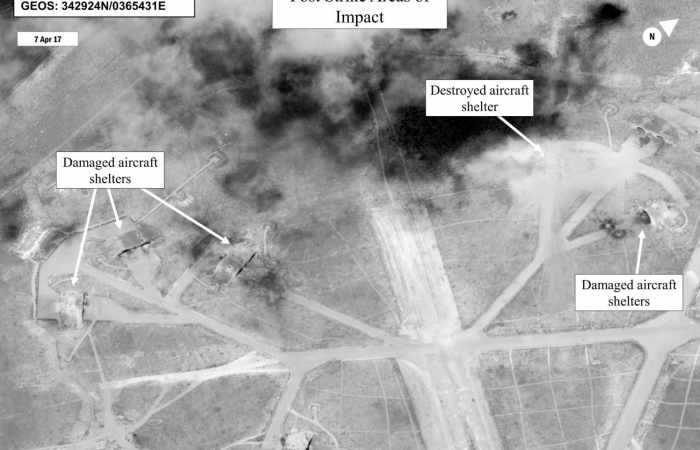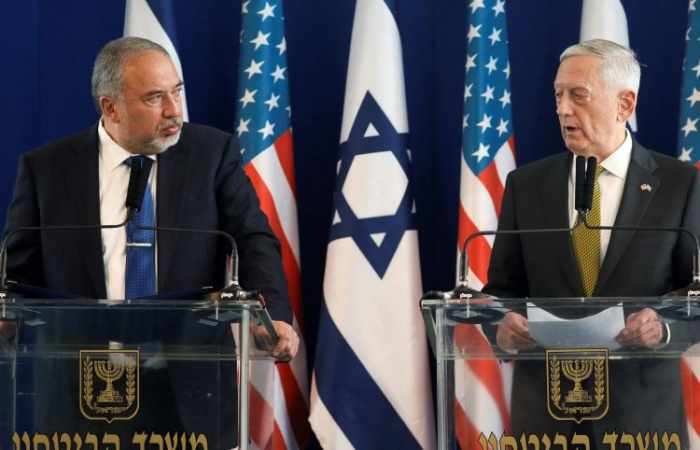Mattis enlisted in the Marine Corps in 1969, but it was during the Obama administration that he rose to greatness, helping to shape rather than merely execute the president’s security policy in the region, before retiring as commander of CENTCOM in 2013, at 63.
The most important aspect of all of these contacts is continuity and proximity, sometimes literally. The USS Ross, a guided-missile destroyer and one of the ships from which the Tomahawk missiles were launched on April 6, regularly anchored at the Israel Navy base in Haifa. The destroyer (along with USS Laboon) docked with a friendly fleet, giving its sailors an opportunity to relax on the beach and tour Israel’s Christian sites.
On a brief press visit to the naval base, it was particularly interesting to note the similarities and differences between the experienced officers and noncommissioned officers – each with 20 years or more of military service – and the young men and women at the lowest ranks. Members of both groups, around 280 in all, wear uniforms and operate warships, but there is no sense of a combat atmosphere. The massive maritime clashes between warring task forces exist only in the archives.
The U.S. destroyers work in pairs, providing cover for each other (the USS Porter was the other destroyer involved in the Syrian airstrike). Not so in the Israel Navy, which in October 1967 lost the INS Eilat, a Z-class destroyer, to small but speedy Soviet-Egyptian missile boats, and then retired the INS Haifa and INS Jaffa, lest they too fall victim to their inferiority in the era of missiles and electronic warfare. The IDF no longer has such outdated ships, but the U.S. Navy does.
Originally intended to protect larger vessels – patrol ships and battleships – and to escort civilian convoys, for the past few decades they have mainly served as floating bases for sea-to-sea and sea-to-surface missiles. The munition that is fired from them, at distant land targets, is precise and does not endanger them. For the attack in Syria, the destroyers – which belong to the naval branch of EUCOM – were placed under the temporary operational control of CENTCOM, returning to EUCOM after the mission was completed.

CENTCOM did not yet exist at the time of the previous U.S.-Syrian confrontation in this arena, in 1983. Then, the enormous but ancient battleship the USS New Jersey fired huge, 2,700-pound shells – described as “flying Volkswagens” – at targets of a pro-Syrian militia in Lebanon’s Chouf mountains. During the escalation, fighter planes from the Sixth Fleet were deployed. A U.S. plane was shot down, its pilot killed and its navigator captured. Syria’s then-president, Hafez Assad, nobly agreed to release him only after Rev. Jesse Jackson (a political rival of then-President Ronald Reagan) came to Damascus for a joint propaganda project. The Russians, still under the “Soviet” label, were already there, with surface-to-air missiles that clipped the wings of the Israel Air Force.
What is mass destruction?
The Syrian-Israeli-American-Russian quadrangle is there once again, under different circumstances. The context for the Tomahawk strike was not Syrian President Bashar Assad’s civil war with rebel forces, but his use of chemical weapons. The distinction is an important one, which bridges the gap between the U.S. rule of only using force in Syria against Islamic State and the exception to this rule. According to this perspective, preventing another chemical weapons attack is vital to U.S. national and security interests. It’s a position U.S. National Security Adviser H.R. McMaster and his colleagues, who are loath to get caught up in a local conflict, can defend.
It is no different, in principle, from the decision by then-President George W. Bush, a decade ago – as related to Haaretz by the CIA’s then-Director Michael Hayden – to take action against the North Korean nuclear reactor in Syria. The Americans contributed intelligence; Israel brought its military might. In the new circumstances of the internal conflict in Syria, Israel’s involvement focuses on obtaining intelligence (and distributing it to its allies), and on treating ill and wounded Syrians.
The first three months of Trump’s presidency were full of ludicrous sharp turns and reversals from his campaign promises. All the nonsense actually obscured the claims he hasn’t gone back on, as well as the ones to which he has not returned. For example, his attack on the U.S. intelligence community for erring in its assessment of Saddam Hussein’s weapons of mass destruction capabilities – as a result of which, according to Trump, it cannot be trusted to investigate the ties of Trump and friends to Russia, or on any other matter.
But when it comes to chemical weapons in Syria, the same intelligence becomes credible and trustworthy. Or perhaps it doesn’t matter and what’s really important is what’s on Fox News, or what Ivanka said to Daddy. Trump is detached from the details: It was Gen. John Nicholson, the top U.S. commander in Afghanistan, who gave the order to drop the “mother of all bombs,” killing 36 ISIS fighters in Southern Nangarhar. Nor does Trump, the commander in chief, have any idea where U.S. aircraft carriers are going – to his country’s embarrassment.
The problem is that the bombastic term “weapons of mass destruction” eludes an agreed-upon definition. In the Department of Defense’s Dictionary of Military and Associated Terms, they are defined as “chemical, biological, radiological, or nuclear weapons capable of a high order of destruction or causing mass casualties,” but “mass casualty” on its own refers to events such as a military aircraft accident or natural disasters that produce a large number of casualties in a relatively short period of time.
In Israel’s military lexicon, mass destruction refers to nuclear, chemical or biological weapons that can cause a large number of casualties over large areas. When Syria began to develop missiles with chemical warfare capabilities three decades ago, then-U.S. Secretary of State George P. Shultz warned his Soviet counterpart, Eduard Shevardnadze, saying: “Without getting into whether or not Syria intended to use such weapons, their existence would represent a threat to Israel. It was impossible to state how Israel might react to such a threat. Thus, the potential existence of a Syrian chemical weapons capability was a threat to regional stability.”
Shevardnadze, who was being asked to dissuade Hafez Assad from pursuing a chemical weapons program, responded by saying that if the U.S. information about Syria were correct, it would be not only unpleasant, but “inadmissible.” In the name of balance, however, the Soviet foreign minister introduced into the conversation Israel’s nuclear program, saying he knew the Syrians were very concerned about the possibility that Israel would obtain nuclear weapons and delivery systems, including missiles.
Colin Powell, who was a high-ranking officer on active duty when he also served as national security adviser between 1987 and 1989, attended the Shultz-Shevardnadze talks. He presented the positions of the Reagan administration, which sought, and succeeded, in reaching a ban on chemical weapons. But as a military man, he minimized the threat they posed. After resigning his post in both Bush administrations, in both Iraq wars, Powell said that soldiers needn’t fear a gas attack – they move on and avoid being hurt, because the gases were only dangerous for people who remained at the site of the attack. Small comfort to civilians, including the young and elderly, who are gassed in a confined space.
When Saddam was captured in December 2003 and brought in for questioning – he talked about how he fooled even people who were close to him when he implied he had weapons of mass destruction – the FBI agent who interrogated him was George Piro. Piro is now heading the FBI’s Miami field office.
On Tuesday, he and his colleagues in Florida’s law agencies announced, to great fanfare, that thanks to the case they put together, a judge sentenced Harlem Suarez to life imprisonment for attempting to procure a weapon of mass destruction and use it in order to aid ISIS. Nuclear? Chemical? Biological? Suarez, who moved to the United States from Cuba when he was 11, wanted to make a nail bomb, to conceal it in a backpack he planned to bury in the sand on a beach in Key West, and then detonate it remotely using a cellphone. Like any attack carried out in a crowded area, his scheme could have caused many deaths. But it’s not exactly “mass destruction” – notwithstanding the fact that in the 1770 incident that went down in history as the Boston Massacre, five people were killed and six others were wounded.
Amir Oren is a senior correspondent and columnist for Haaretz and a member of the newspaper's editorial board. He writes about defense and military affairs, the government and international relations.
More about:
















































